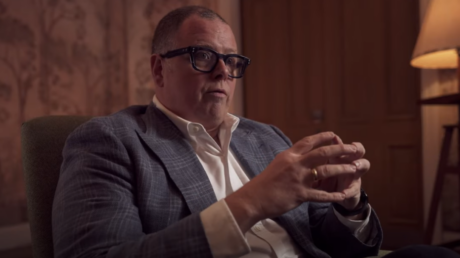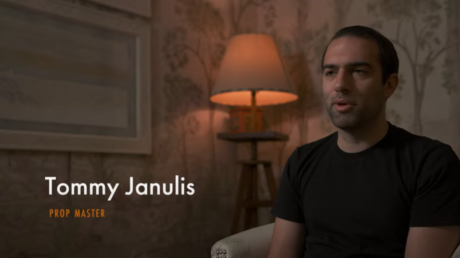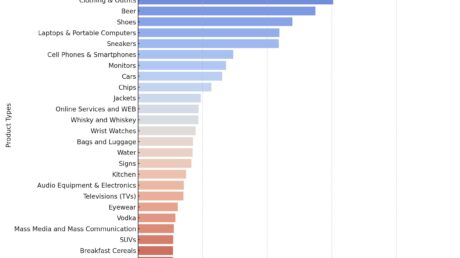You’re a brand itching to be part of the cultural conversation. Maybe you’re a movie lover and curious how your favorite beer ended up on the latest binge-worthy TV show. Or you’re hearing from friends, family, and other marketers how a brand ended up as a huge part of a story.
Product placement has a rich history in the entertainment industry.
Forty years later, viewers still remember Eliot leading his soon-to-be best friend alien out of the woods with Reese’s Pieces in “E.T. the Extra-Terrestrial.” Since season one’s launch in 1998, loyal fans cheered when Mr. Big finally proposed to Carrie in the Sex and the City movie with a now infamous pair of Manolo Blahnik heels.
Product placement is everywhere, and it’s led to some pretty epic moments in entertainment. This page answers all your burning questions about how product placement works and why it’s so transformative for brands, agencies, production partners, and audiences.
General
What is product placement?
You might not even realize how many products appear in feature films, broadcast, and cable programming, and streaming services. That’s what makes product placement so effective. It naturally—and seamlessly—weaves a product into content and allows viewers to stay engrossed in the story, while also providing big benefits for brands.
A great example is Buick in HBO’s critically acclaimed show Big Little Lies. The 124-year-old brand’s product placement helped change its reputation after Reese Witherspoon’s character Madeline Mackenzie drove the car throughout the series. Of viewers, 69% said that Buick’s placement improved their opinion of the brand and 89% said the placement increased the likelihood that they would purchase a Buick.
Like Buick’s newfound appeal among younger consumers (and their grandparents too), brands can reach new audiences and win big by using this authentic form of advertising.
What else is product placement called?
Now that you know what product placement is, let’s get you up to speed on the lingo. Should you call it product placement or brand integration? Truthfully, it’s tomato-tomato. Historically, brand integration meant a paid opportunity where product placement was unpaid. However, times have changed, and our industry uses the terms interchangeably. When it comes to referring to product placement, either of these terms works just fine.
What are the different types of product placement?
Now that we’ve set the table, you’re likely thinking about which type of product placement is right for your brand. Let’s unpack the top four approaches to product placement for you:
- Story-driven placements, also known as narrative placement, may help define a character and drive a story forward, such as Netflix’s Stranger Things. The character Eleven’s waffle obsession made Eggo Waffles the talk of the town, and Kellogg’s can trace skyrocketing sales directly to the show. Eggo’s revenue jumped 9.4% during the first half of 2018 — which is when season 2 aired.
- Prop placements are exactly what it sounds like – productions using a brand’s products as props. If you’re a brand with a variety of packaged goods, fashion, or electronics, prop placement may be well suited to achieving your goals. Wine and spirit seller Pernod Ricard used prop placement in artist Normani’s “Wild Side” music video featuring Cardi B. Because the video ranked as the number one trending US video on YouTube, the placement made Pernod Ricard culturally relevant.
- Branded content is a great approach if you’re looking to build brand awareness. Branded content allows a brand to go deeper with their messaging and educate customers on their brand. You’ll likely see branded content included in unique branded formats like daypart or late-night series. TurboTax, for example, earned 10.8 million impressions after extending its Super Bowl ad into a custom Jimmy Kimmel Live! segment.
- Virtual placements are the newest type of product placement. Thanks to technological innovation, virtual placements allow brands to virtually insert their brand into a production whether that’s via a digitally rendered product, billboard, or logo.
What’s the difference between endorsement, sponsorship, and product placement?
The short answer is that product placement is the only advertising option amongst these three that seamlessly weaves a brand into content. Product placement makes the brand part of the story in a way that doesn’t interrupt the narrative. (See “What is Product Placement” above).
Endorsements generally tap celebrities with a high degree of recognition, trust, or respect. The celebrity lends a product their name or image to promote it. An example of this is the long-running Jennifer Aniston endorsement for Smart Water.
A sponsorship is when a brand pays a fee to support an organization or event. It usually involves the sponsor business’ brand, logo, image, and/or message being embedded in marketing related to that organization or event. An example of this is Fedex’s sponsorship of the PGA’s 2023 FedEx St. Jude Championship. The PGA event’s website, advertising, and on-site signage, banners, and displays will bear the FedEx logo in exchange for sponsorship dollars.
What are the advantages of product placement?
Product placement is the ultimate brand booster. It helps you get noticed by appearing in content authentically, a much-preferred alternative to in-your-face ads. Plus, it’s way more cost-effective than a traditional media buy, which requires expensive annual advertising budgets. It can make your brand culturally relevant, adding a highly-visible “cool” factor that you don’t typically find in other marketing forms.
Because product placement inserts products and brands into the cultural conversation, it’s simply more effective than traditional advertising. Product placement quickly defines your brand’s characteristics by weaving products into the narrative and/or character’s development. Because product placement can’t be skipped or turned off, it drives stronger awareness, sales intent, and connections to your brand. Integrations last a lifetime, while a commercial only runs until you hit a specific number of impressions.
And here’s a big one that brands think about a lot now: brand safety. Because product placement can be highly-specific, there are none of the headaches in a traditional or digital media buy, where an ad could very well end up in some scary places for a brand. Plus, working with a highly-respected, credible partner that knows the industry inside and out, helps brands land in the perfect place.
Overall, product placement is a win-win situation for both the production and the brand.
Is product placement effective?
So, product placement is cool, but does it actually work? Absolutely!
More than ever, brands can see whether product placement is effective through full funnel measurements that align with their key performance indicators (KPIs), including:
- Attribution Reports that connect first or third party sales data with audience exposure data to evaluate sales lift or website visit lift from integrations;
- Brand Lift Studies that provide custom market research to understand integrations’ impact on recall, opinion, purchase intent, and key brand attributes;
- Media Mix Modeling (MMM) Integration refers to integrating data into existing media mix models to measure a product placement’s impact.
- Earned Media Value: Measuring media value can be another form of proving ROI for product placement. Similar to measuring media value on traditional marketing formats, earned media value for product placement is the monetary value of the product placement exposure put into a quantitative dollar amount representing what is presumed to have been the same engagement through paid branded marketing channels. However, calculating media value for product placement is not exactly 1:1 as it would be for other paid marketing channels, and there are several industry leaders creating their own methodology for calculating media value for product placement moments. SEE HERE for a recent article on YouGov and the PQS tool for an example.
Transparent reporting and cutting-edge measurement solutions allow you to track ROI based on brand lift, sales attribution, or integration into your existing media mix models.
Why use real products instead of fake ones in a production?
Why fake it when you can use the real thing, save money, and be more authentic?
Production partners want to use real products, and product placement makes it easier and more cost-effective to do so. As a result, production pros don’t have to source products, which frees up budget dollars that they can use elsewhere.
Fake products take viewers out of the story whereas real products offer a more authentic and immersive experience. Creating fake brands and products takes a lot of work and adds expense to a production.
Brands & Agencies
How can brands in my category use product placement successfully?
Worried that product placement might not be right for your particular product or service? Don’t be! All brand categories can benefit from a well-done product placement strategy. By using a data-driven approach, brands like yours can be part of this growing content landscape.
Numbers spoke volumes for CarMax, the largest U.S. used car retailer. Looking to establish their authority in a growing marketplace, CarMax implemented a product placement strategy across on-screen moments, late-night TV, and scripted and unscripted content to build their cultural relevance. By casting a wide net and finding impactful integrations, CarMax saw a 9.3% lift in website traffic among their key audiences, 66% unaided brand recall among viewers, and a more than 20-point lift in overall brand rating.
Does product placement make sense for my smaller business?
Product placement is not just for the big players. Because product placement is so effective and scalable, it makes sense for brands, agencies, and productions both large and small. As a truly authentic and effective form of advertising, product placement can yield measurable results for your smaller business.
Go RVing, a small company dedicated to inspiring potential RVers, wanted to make a splash in their busiest time of the year, the summer. An agency partner connected the company with The Ellen Degeneres Show, leading the show’s producers to develop a summer road trip series with (very) young historian and Ellen’s frequent, beloved guest, Macey Hensley, and her family. The series paid off for Go RVing; they received over 15 million views/impressions with over 440 million social media impressions.
How does working with an agency partner help my brand?
Once you work with an agency partner, you’ll never go solo again. Serving as an extension of your team, an agency can represent you to the entertainment community and ensure that your brand is positively positioned in content. Agency partners target opportunities that align with your campaign’s KPIs, work with production partners to secure alignment and educate the community about your brand’s products, philosophy, ideal character and integration scenarios, and brand guidelines. Finally, an agency partner provides detailed reporting and insights to optimize and refine your product placement strategy to strengthen your year-over-year performance.
How do agency partners determine the best placement for my brand?
Agency partners leverage their industry experience and relationships with industry pros to help brands find premier opportunities that are the best fit for their goals and help them reach their target audience. That’s why brands should always look for agency partners with deep-rooted connections in the entertainment industry as it helps them get more access to television, film, and music content.
How much of a say do brands have in their integration?
Product placement works because everyone wants the same thing: a successful placement that is authentic to the creative vision and a brand’s essence. That’s why it’s important for brands to work with agency partners that understand their goals and target the right opportunities based on KPIs and brand guidelines, including do’s and don’ts. Putting in the work in the planning stages and casting a wide net for integrations may open exciting new doors that align a brand with the next big thing.
How much input do brands get on the integration?
While brands don’t have final approval on content, you should count on integrations that fulfill mutually agreed-upon criteria as outlined in your contract. Additionally, it’s important for brands to communicate do’s and don’ts upfront to ensure the production can place your product authentically to their creative vision so it is mutually beneficial to both the content and brand.
Can brands select their preferences for productions and actors?
Work closely with your product placement agency partners to define your preferences. After discussing brands’ campaign KPIs, your agency should provide you with a content strategy and target opportunities. Cast a wide net, rather than targeting a specific production or actor, to find content partners that are the best fit for a campaign’s goals. This process creates a seamless experience for brands and product placements that generate results.
How long does it take to launch a product placement?
Good things come to those who wait. Product placement may take longer than other forms of marketing, but it’s well worth it. Typical “content gestation” periods range from:
- 3-6 months for daytime and late-night programs
- 3-9 months for broadcast and cable television
- 6-12 months+ for streaming/premium cable
- 12-15 months for feature films
Know that each content format has a different content gestation period. While brands can typically find product placements that align with their timing requirements, it’s advisable to work with production partners earlier so brands have a wider range of content to work across.
Production Partners
Why do production partners value product placement?
Production partners love product placement for so many reasons. First and foremost, product placement allows production partners to move stories forward and quickly define characters. I mean, we’d hardly recognize Top Gun‘s Lieutenant Pete “Maverick” Mitchell without his sleek, black Ray-Bans.
For production partners, the creative vision always comes first and recent macro factors–like inflation, supply chain disruptions, and COVID–have made it hard to get projects off the ground due to soaring costs. Raw materials alone currently add 25-30% to a production budget. With brand dollars, product placement allows production partners to help their creative vision reach its fullest potential whether that’s funding extra shooting days, better locations, renowned cast members, and more.




